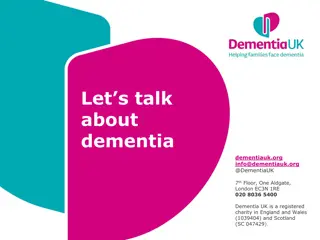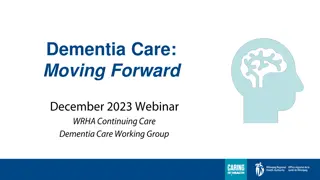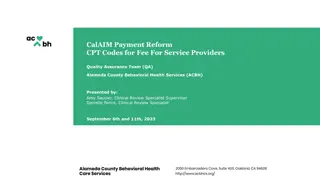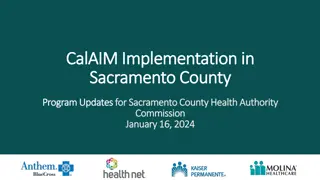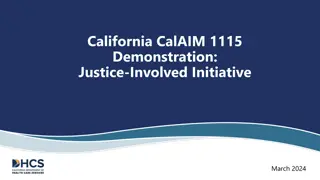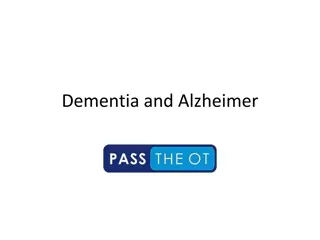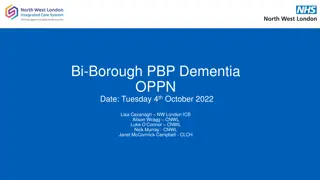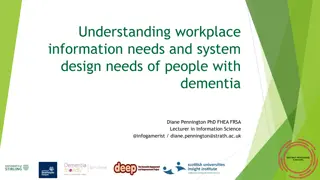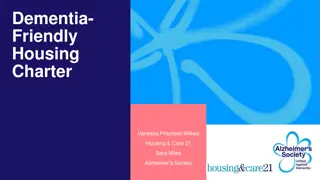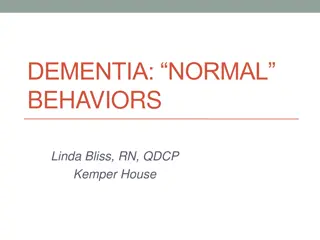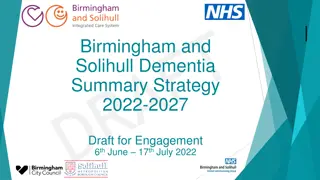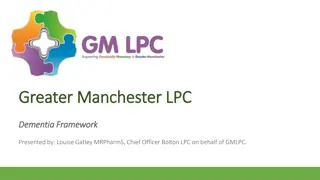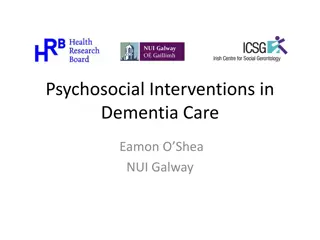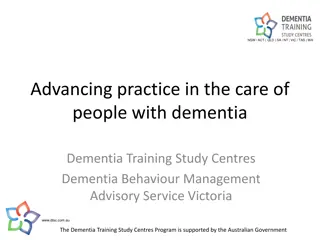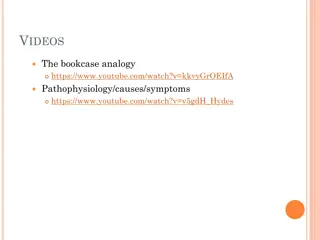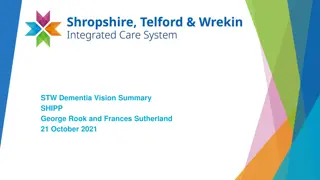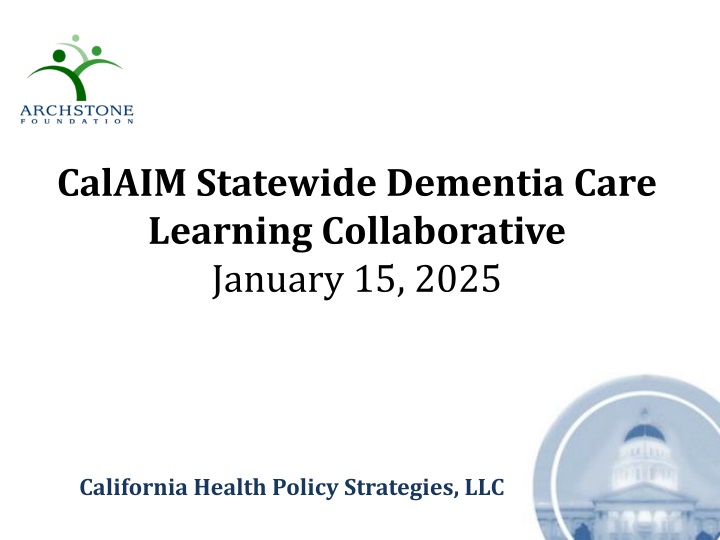
CalAIM Statewide Dementia Care Learning Collaborative
Welcome to the CalAIM Statewide Dementia Care Learning Collaborative. Stay updated on IHSS program referrals, announcements, and upcoming meetings. Explore opportunities for collaboration between IHSS and CalAIM, presented by Cathy Senderling-McDonald. Gain insights into IHSS clients, CalAIM populations of focus, overlaps, and project overview. Learn about IHSS structure, overlaps, and referral processes. Connect with Catbird Strategies led by Cathy Senderling-McDonald, a seasoned professional in health and human services policy and practice.
Download Presentation

Please find below an Image/Link to download the presentation.
The content on the website is provided AS IS for your information and personal use only. It may not be sold, licensed, or shared on other websites without obtaining consent from the author. If you encounter any issues during the download, it is possible that the publisher has removed the file from their server.
You are allowed to download the files provided on this website for personal or commercial use, subject to the condition that they are used lawfully. All files are the property of their respective owners.
The content on the website is provided AS IS for your information and personal use only. It may not be sold, licensed, or shared on other websites without obtaining consent from the author.
E N D
Presentation Transcript
CalAIM Statewide Dementia Care Learning Collaborative January 15, 2025 California Health Policy Strategies, LLC
Agenda Welcome and Introductions Updates IHSS program referrals Announcements and Upcoming meetings California Health Policy Strategies, LLC 1
Updates ECM MANAGERS/DIRECTORS AD-HOC MEETING WEDNESDAY, JANUARY 22 AT 2:00 PM Topics for discussion: ECM Referral Forms, Transitional Benefits, and IHSS linkages Meeting for ECM Managers/Directors only email Jasmine at jlacsamana@archstone.org for link to register California Health Policy Strategies, LLC 2
Managed Care Plans ECM Managers/Directors Ad-Hoc Meeting Wednesday, January 22 at 2:00 PM Topics for discussion: ECM Referral Forms, Transitional Benefits, and IHSS linkages Meeting for ECM Managers/Directors only email Jasmine at jlacsamana@archstone.org for link to register California Health Policy Strategies, LLC 3
IHSS and CalAIM: Opportunities for Collaboration January 15, 2025 Presented by Cathy Senderling-McDonald CalAIM Dementia Collaborative
Goals of This Presentation Refresher on IHSS Program and CalAIM ECM Benefit IHSS Clients and CalAIM Populations of Focus Overlaps Snapshot of Current IHSS Caseloads and ECM Uptake Project Overview: Increasing Referrals in IHSS Discussion /Feedback 5
IHSS & CalAIM ECM Structure | Overlaps & ReferralProcesses
Catbird Strategies Cathy Senderling-McDonald, CEO 28 years experience in health & human services policy and practice 23yearswithCountyWelfare DirectorsAssociationofCA Staffed SenateBudget Committee,LegislativeAnalyst sOffice Budget,LegislativeProcessesand Administrative Advocacy 7
In-Home Supportive Services (IHSS) IHSS provides in-home assistance to eligible elder adults and adults or children who are sight impaired or have disabilities. IHSS is an alternative to out of home care and enables recipients to remain safely in their own homes. IHSS have been assessed as having a need for services offered by the program. A Medi-Cal eligibility determination is required, as is an in- home assessment by a county IHSS social worker to identify and document service needs. Those found eligible for IHSS receive a monthly authorization for a certain number and type of service hours to help with activities of daily living. Providers are hired, supervised and fired by the IHSS recipient and are paid according to an hourly wage negotiated in each county. Some counties also offer contracted staff or homemaker employees. 8
IHSS Roles and Responsibilities The Department of Health Care Services (DHCS) maintains the State Plan authority under Medicaid to draw down federal funding for eligible recipients. The Department of Social Services (CDSS) administers the day-to-day aspects of the program at the state level and operates the information technology system, CMIPS. County Human Services Agencies administer the program locally, including assessing eligibility and authorizing hours and types of service. Public Authorities in each county oversee IHSS provider enrollment and training, conduct background checks, make referrals, maintain registries of providers, and negotiate wages and benefits. IHSS providers care for recipients according to authorized hours and types of service. IHSS recipients hire, fire, and supervise their own providers. 9
IHSS Services (all must be approved) Domestic services Meal preparation and cleanup Laundry Shopping for groceries, other shopping or errands Nonmedical personal care services, such as bathing, grooming, dressing, bowel and bladder care Accompaniment to medical appointments Paramedical services (e.g., wound care, help with medicine, feeding tubes, home therapy treatments) Protective supervision (authorized only for individuals with mental impairments such as impaired cognition, judgement or memory) Heavy cleaning, yard hazard abatement (generally one time or time limited benefits when needed under special circumstances) 10
CalAIM Enhanced Case Management A whole-person, interdisciplinary approach to care that addresses clinical and non-clinical needs of MCP members with the most complex medical and social needs. ECM provides systematic coordination of services and comprehensive care management that is community based, interdisciplinary, high touch and person centered. DHCS envisions ECM coordinating all care for MCP members who receive it, including across physical and behavioral health delivery systems. ECM is a statewide Medi-Cal benefit. 11
Adult ECM Populations of Focus Adults Living in the Community &At Risk for LTC Institutionalization Adultswho: (1) Are living in the community who meet the SNF Level of Care criteria, OR who require lower-acuity skilled nursing such as time-limited and/or intermittent medical and nursing services, support, and/or equipment forprevention, diagnosis, ortreatment ofacute illness or injury. AND (2) Are actively experiencing at least one complex social or environmental factor influencing their health (including, but not limited to, needing assistance with activities of daily living, communication difficulties, access to food, access to stable housing, living alone, the need for conservatorship or guided decision- making, poor or inadequate caregiving which may appear as a lack of safety monitoring); AND (3) Are able to reside continuously in the community with wraparound supports (i.e., some individuals may not be eligible because they have high-acuity needs or conditions that are not suitable for home- based care due tosafety or other concerns). 12
ECM Core Services ECMProviders are required tooffer all sevenofthesecoreservices. ECMLeadCareManagers are stronglyencouraged toscreen MCP membersreceiving ECMforcommunity supportneeds.Community supportsare services provided by MCPsascost-effective alternatives totraditionalmedical services orsettings. AllMCPsare encouraged toofferas manyof the 14 Community Supports as possible, butnotall plans mayoffer theentire suiteof services.Examples ofCommunitySupports include: AsthmaRemediation MedicallySupportiveFood/Medically TailoredMeals Respite Services Short-Term Post-Hospitalization Housing HousingTransition NavigationServices HousingDeposits HousingTenancyandSustaining Services SoberingCenters HomeModifications PersonalCareServices Day Habilitation Programs NursingFacilityTransition CommunityTransition Recuperative Care 13
IHSS and ECM Overlaps IHSS recipients can also receive ECM services if theyareenrolled in a managedcareplan, meetECM population of focus criteria. IHSS adults should generally meet the criteria given the underlying requirements of the IHSS program (i.e., the SOC 873). Both children and adults mayreceive both IHSS and ECM if they meet criteria for both sets of services. It is crucial to avoid service duplication across IHSS and ECM. Datacollectedtodatesuggestthatthe vastmajority ofIHSS recipientsarenotreceivingECM, despitelikely eligibility formany. 14
Referring IHSS Recipients to ECM Referralscanbemadefrom multiple sources, most likely: County IHSS Social Worker Public Authority Staff IHSS Provider DHCSproduced templatereferralforms thatMCPs cancustomize Ifindividual meets the POF definition, theyare eligible for ECM MCPscannot add requirements or narrow the POF definition 15
Snapshot: Program Data IHSS Caseload | ECM Receipt |Connecting the Dots
IHSS Data: Caseload and Gender November2024 809,972Recipients served by719,614providers 36.7% considered Severely Impaired |Average159.9 hours/mo 62.9%considered Non-Severely Impaired |Average92.9 hours/mo 62.9% considered Disabled 36.0%considered Aged 1.1% considered Blind 57.4% female (468,753) |42.6%male (348,127) 17
IHSS Data: Age Breakdown November 2024:IHSS Recipients, Percentby Age 25 21.0% 20.5% 19.6% 20 14.3% 14.2% 15 10.4% 10 5 0 0-17years 18-44years 45-64years 65to 74years 75to 84years 85+years 18
SOC873:HealthCareCertificationForm Statelawrequires thatin order forIHSS services tobe authorized orcontinuedalicensed health careprofessional mustprovide a certification declaring the individual aboveisunable to performsomeactivity of daily living independentlyan withoutIHSS theindividual wouldbe atriskof placement in out-of-home care. d 11 Downloadat:https://www.cdss.ca.gov/cdssweb/entres/forms/english/soc873.pdf
ECM Data: Receipt of ECM 244,800unique members received some kindofECM benefit since ECM launched in January 2022 176,000unique members receivedECM during themost recent 12 months, from July 1, 2023 through June 30, 2024. Therecent trendhasbeen towards continued growth, with 127,000unique members receiving ECM during themost recent reporting period of April 1 through June 30, 2024. 17 Source: DHCS,accessedat:https://storymaps.arcgis.com/collections/a07f998dfefa497fbd7613981e4f6117?item=4
ECM Data: Receipt by Age, Quarterly 18 Source: DHCS,accessedat https://cadhcs.maps.arcgis.com/apps/dashboards/a622d2397ff6457eb13d65db9f301d61
Increasing IHSS ECM Uptake Key Assumptions|Data |Toolkit
Where We Are Assumptions AboutIHSSReferralstoECM Lack of training about how to make a referraland why/when to do so Lack of materials targetedtowards keyIHSS constituencies Greater focus should lead tomore referralsand greater uptake Needfor regular datasharingacrossprograms StateEngagement Datareports develop and/or restartfor MCPs toutilize Toolkit development andmaintenance Monitor uptakespecifically in IHSS population Timing is good (2025 goals) 24
3 Major Project Components 1. Review and Analysis Program Data,Reporting, and Data SharingAcrossDHCS/MCPs Training and OutreachMaterials ReferralToolsand Processes 2. Development ofFocused IHSS/ECM Toolkit TargetedTraining andOutreach Materials Potential Enhancements to ReferralTools and Processes 3. Test, Refine andDisseminate Materials Refine Basedon Feedbackfrom Pilot Testing DisseminatetoMCPs,Counties, Public Authorities,Unions/Providers 25
Seeking Feedback & Partnership Are we on the right track? Are we diagnosing the situation correctly? Whatare we missing? Doyou wantto help? Needplans, counties, PA s,union support! Email csm@catbirdstrategies.comor drop info in chat ***Huge thankstoArchstone Foundationforfundingproject & to CalHPS for the opportunity to be involved*** 26
Thank You! Cathy Senderling-McDonald, CEO csm@catbirdstrategies.com
Resource Links DHCS: https://www.dhcs.ca.gov/CalAIM/ECM/Documents/ECM-Policy-Guide.pdf DHCS: Enhanced Care Management for Children and Youth: A Population of Focus Spotlight https://www.dhcs.ca.gov/CalAIM/ECM/Documents/ECM- Children-And-Youth-POFs-Spotlight.pdf Justice In Aging Issue Brief: Breaking Down Barriers to Personal Care Services: Unlocking Vital Services for Those Who Need Them Most - https://www.capaihss.org/wp-content/uploads/2024/11/Breaking-Down- Barriers-to-Personal-Care-JIA-Oct-24.pdf California Health Care Foundation Fact Sheet: In-Home Supportive Services 101: Opportunities and Challenges Under CalAIM (Prepared by Chapman Consulting) - https://www.chcf.org/publication/in-home- supportive-services-101-opportunities-and-challenges-under-calaim/ Enhanced Care Management Policy Guide - 28
Relevant Populations of Focus Children and Youth Populations of Focus Children andYouthExperiencing Homelessness Children and YouthatRiskforAvoidableHospitalorEmergency DepartmentUtilization Children and YouthWithSeriousMentalHealth and/orSubstance UseDisorderNeeds Children and YouthEnrolled inCalifornia Children s Services(CCS) orCCSWhole ChildModelwith AdditionalNeedsBeyondthe CCS Condition Children and YouthInvolved in Child Welfare Birth Equity Individuals Transitioningfrom Incarceration 29
Upcoming Meetings Upcoming Collaborative Meetings Register here for all 2025 meetings Meeting #15: Wednesday, February 12, 12:00 1:00 PM Meeting #16: Wednesday, March 12, 12:00 1:00 PM Meeting #17: Wednesday, April 2, 12:00 1:00 PM Meeting #18: Wednesday, May 14, 12:00 1:00 PM Meeting #19: Wednesday, June 11, 12:00 1:00 PM Next Collaborative Meeting Wednesday, February 12th at 12:00 PM Topic of Focus: Transitions to Community from Skilled Nursing Facilities DHCS All Comer Webinar on Closed-Loop Referral Implementation Guidance February 13, 10:00 AM Register at: https://manatt.zoom.us/webinar/register/WN_M4BRoACsQpSfB7zjZ2E1lQ#/registration California Health Policy Strategies, LLC 30

